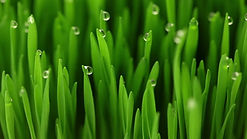
Grass Care Tips
Green, Groomed and Growing every season of the year
To achieve a lush, green lawn follow these suggestions:

TEST YOUR SOIL
Contact your local County Extension Agent or Google "Soil testing labs near me" to find an agricultural lab close by. You should have a soil test to find out your soil's nutrient analysis for fertilizer applications and the percent sand, silt and clay of the soil which can be a guide on how the soil drains or holds water. Test any trouble areas separately to help diagnose potential problems.

FERTILIZE
It is important to feed grass to have it healthy and actively growing. The healthier the grass and deeper the roots, the better it can handle drought stress and wear from the family's weekend-long backyard baseball tournaments. Refer to the soil analysis mentioned above and select an appropriate fertilizer. Preferably a slow release product that will provide a continuous feed, but not prompt a flush of growth causing you to have to mow more and stress the plants. Read and follow all label instructions on the bag carefully. Only use what is recommended.
What the numbers on the fertilizer stand for are as follows:
-
(N) nitrogen- promotes foliage growth
-
(P) Phosphorus- aids with germination
-
(K) Potassium- helps with drought tolerance and wear and tear.
Apply micro-nutrients; that is Iron (Fe++) and Manganese (Mn) to get a lush dark green color without prompting a flush of growth. Lessen the chance of uneven application by using a broadcast spreader to apply fertilizer and micro-nutrients.
Always water after an application of fertilizer, or fertilize before a rain to let nature give you a hand. Remember you get what you pay for, the rule applies to fertilizers, too.
What not to do:
-
Never fertilize on frozen ground. Chances are that the nutrients won't be used by the plants but simply washed away into the local groundwater.
-
Don't think a little is good so a lot will be better. You will only cause problems for the plants, turf or trees and the environment.
-
Never fertilize in hot weather. Fertilizers are made of salts and too much salt will suck the moisture out of the plant, commonly called burning.
-
Use caution and smarts in storing your horticultural chemicals. When not stored properly they can cause harm.

AERATING
If you have wear areas, shallow rooting, and/or drainage problems you might need to core aerate. Core aeration is a significant maintenance practice used to relieve compaction in wear areas, help rooting and overall establishment of grass. The cores need to be broken up, dragged in and/or cleaned up. This takes a lot of effort. After clean up, follow with over seeding, fertilizing and watering to fully benefit from your hard work.

MOWING
While we mow our cool season Kentucky Bluegrass between 1 and 1-1/8 inch cutting height for playability, I recommend home owners cut their grass between 2.5-3.5 inches. The extra grass blade length helps shade the roots and soil to reduce evaporation. To reduce stress on the grass never remove more than 1/3 of the length of the grass blade at a time. Mow more often if you necessary to achieve this. Don't drive the mower too fast. Quick turns can result in an uneven cut or scalping. Keep your mower blades sharp to help achieve a clean cut. Homeowners should check their mower blade before mowing and sharpen them once a month or as needed. A dull mower blade shreds the grass blades which leads to wounds that can contribute to the grass drying out. Take advantage of the off season to get the mower engine and drive train serviced.

SEEDING
When seeding, make sure that you use the right seed for your growing conditions. Read the seed label. Be sure to buy quality, certified seed. It will cost more, but it is money well spent. You want a low percentage of crop seeds and the germination rate should be at least 85%.

WATERING
No one can water like Mother Nature. When watering your grass be sure to follow all water restrictions in your area. A good rule of thumb for water required by turf grass is 1 inch per week. It is better for the grass to be irrigated between 2am and 7am to decrease evaporation and so the water is available to the grass as daytime temperatures rise. Many homeowners water their grass when they get home from work and then the grass is wet all night which can lead to the grass being more susceptible to disease. If as a homeowner you don't have automatic in-ground irrigation, you can set a timer hooked up between the hose and house water spicket that can be set to go on and off between 2am and 7am. A traveling sprinkler can be used for larger areas. Automatic irrigation heads and sprinklers should be tested to be sure they are working properly and not watering the driveway, where water may flow into the storm sewer.